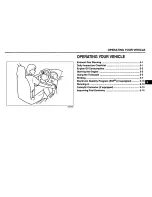
07 Wheels and tires
General information
07
174
Introduction
Your vehicle is equipped with tires according
to the vehicle's tire information placard on the
B-pillar (the structural member at the side of
the vehicle, at the rear of the driver's door
opening).
CAUTION
Some Volvo models are equipped with an
Ultra High Performance tire and wheel com-
bination designed to provide maximum dry
pavement performance with consideration
for hydroplaning resistance. They may be
more susceptible to road hazard damage
and, depending on driving conditions, may
achieve a tread life of less than 20,000 miles
(30,000 km). Even if this vehicle is equipped
with Volvo’s advanced AWD or DSTC sys-
tem, these tires are not designed for winter
driving, and should be replaced with winter
tires when weather conditions dictate.
The tires have good road holding characteris-
tics and offer good handling on dry and wet
surfaces. It should be noted however that the
tires have been developed to give these fea-
tures on snow/ice-free surfaces.
Most models are equipped with "all-season"
tires, which provide a somewhat higher degree
of road holding on slippery surfaces than tires
without the "all-season" rating. However, for
optimum road holding on icy or snow-covered
roads, we recommend suitable winter tires on
all four wheels.
When replacing tires, be sure that the new tires
are the same size designation, type (radial) and
preferably from the same manufacturer, on all
four wheels. Otherwise there is a risk of altering
the car's roadholding and handling characte-
ristics.
New Tires
Remember that tires are perishable goods. As
of 2000, the manufacturing week and year
(Department of Transportation (DOT) stamp)
will be indicated with 4 digits (e.g., 1510 means
that the tire illustrated was manufactured dur-
ing week 15 of 2010).
Tire age
Tires degrade over time, even when they are
not being used. It is recommended that tires
generally be replaced after 6 years of normal
service. Heat caused by hot climates, frequent
high loading conditions or Ultra Violet (U.V)
exposure can accelerate the aging process.
The temporary spare
1
should also be replaced
at 6-year intervals, even if it has never been
used.
A tire's age can be determined by the DOT
stamp on the sidewall (see the illustration).
A tire with e.g., visible cracks or discoloration
should be replaced immediately.
Improving tire economy
•
Maintain correct tire pressure. For the tire
pressure tables, see page 179.
•
Drive smoothly: avoid fast starts, hard
braking and tire screeching.
•
Tire wear increases with speed.
•
Correct front wheel alignment is very
important.
•
Unbalanced wheels impair tire economy
and driving comfort.
•
Tires must maintain the same direction of
rotation throughout their lifetime.
1
Option or accessory on some models
Summary of Contents for S40 2011
Page 1: ...VOLVO V50 Owner s Manual Web Edition ...
Page 2: ......
Page 8: ...Contents 8 12 12 Index Index 282 ...
Page 9: ...Contents 9 ...
Page 17: ...SAFETY ...
Page 51: ...INSTRUMENTS AND CONTROLS ...
Page 52: ...02 Instruments and controls Instrument overview 02 52 G019488 ...
Page 91: ...CLIMATE ...
Page 103: ...INTERIOR ...
Page 111: ...04 Interior Storage compartments 04 111 ...
Page 121: ...LOCKS AND ALARM ...
Page 137: ...STARTING AND DRIVING ...
Page 171: ...06 Starting and driving 06 171 ...
Page 173: ...WHEELS AND TIRES ...
Page 202: ...202 Washing and cleaning the car 204 Paint touch up 208 ...
Page 203: ...CAR CARE ...
Page 209: ...08 Car care 08 209 ...
Page 211: ...MAINTENANCE AND SERVICING ...
Page 239: ...AUDIO ...
Page 263: ...10 Audio 10 263 ...
Page 265: ...SPECIFICATIONS ...
Page 266: ...11 Specifications Label information 11 266 ...
Page 281: ...11 Specifications 11 281 ...
Page 290: ...12 Index 12 290 ...
Page 291: ......
Page 292: ...Kdakd 8Vg 8dgedgVi dc IE JH6 8VcVYV 6I Eg ciZY c HlZYZc iZWdg 8deng i Kdakd 8Vg 8dgedgVi dc ...
















































